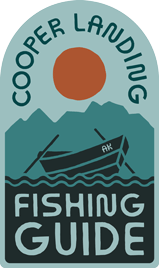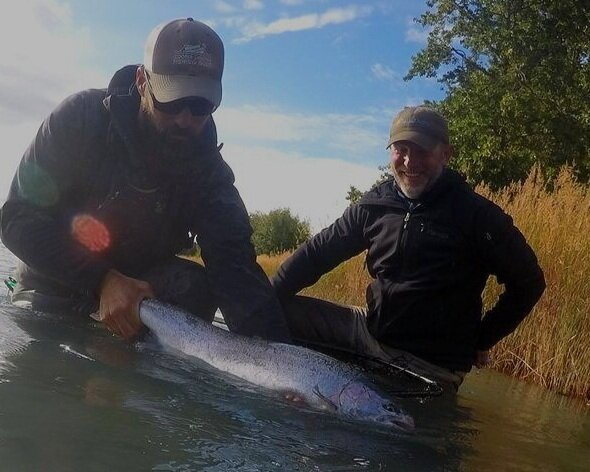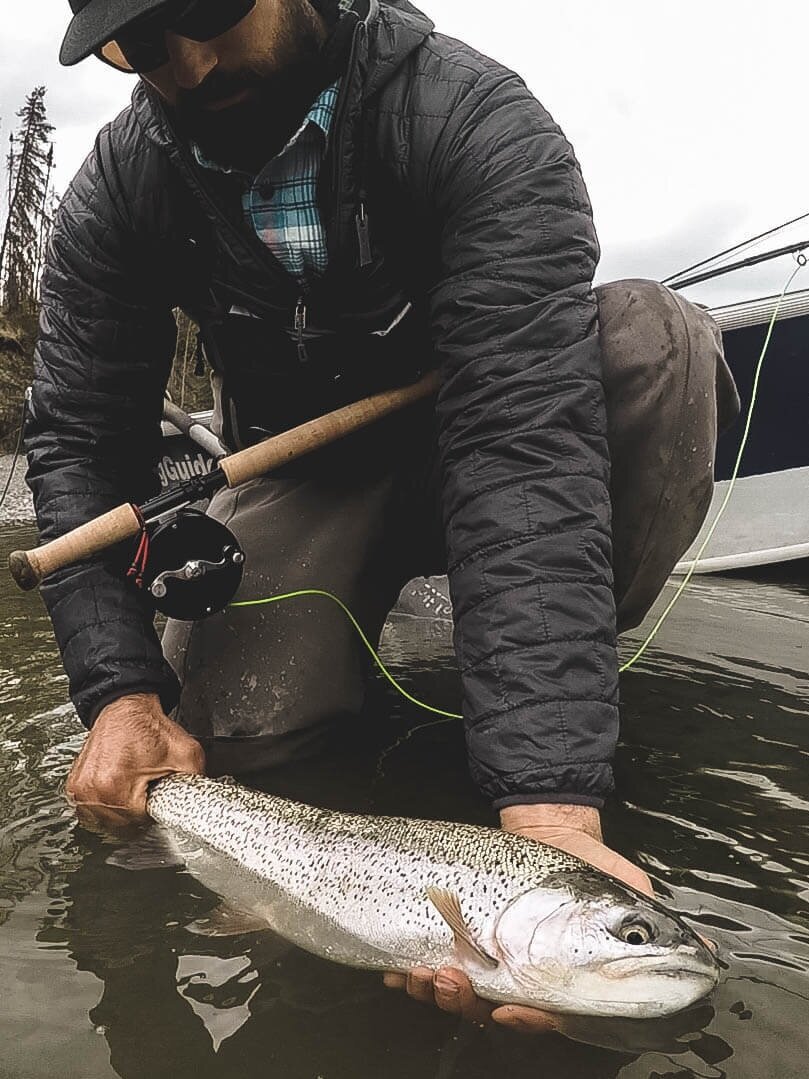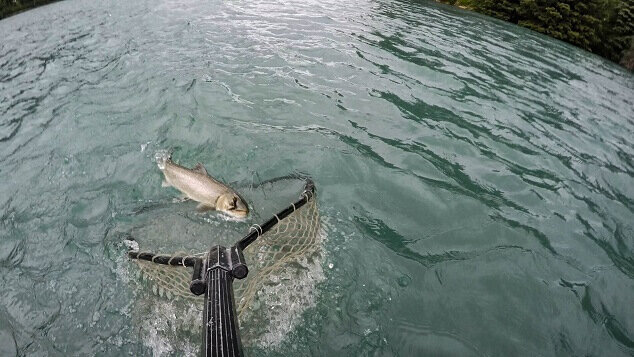HOW TO LAND BIG TROPHY FISH
TIPS TO HELP YOU LAND THAT BIG FISH OF A LIFETIME:
LAND BIG FISH FROM THE SHORE OR FROM A BOAT, WITH OR WITHOUT A NET.
Landing big fish and trophy fish is something every angler hopes to do every time they go fishing. Whether catching trophy fish in a river, lake, stream or ocean, landing a fish of a lifetime requires a little bit of luck and some experience. It also requires knowing where and how to catch them. Finally, it requires knowing what equipment to use and how to fight them once they are on your line.
John landed this big 32” Alaskan Steelhead while on a fishing trip to the Kenai River in September.
Luckily, living in Alaska gives us plenty of opportunities to encounter trophy trout and salmon. This gives us lots of experience fighting big fish on a regular basis. Living near the Kenai River, we often encounter bigger fish. If you don’t live in an area that has lots of big fish and hope to land big fish one day, you’ll need to prepare yourself with knowledge instead of experience. We outline several tips below to land that big fish of a lifetime so your next big fish won’t be the one that got away!
FINDING BIG FISH TO CATCH
The first key to landing big fish is knowing where to find them. Finding larger fish really comes down to knowing the water you are fishing. Does the body of water you’re fishing hold big fish? Or... are big fish rare in your area?
If you really want to find big fish to catch, you must seek out water that is known to hold them.
Do research online
In-person research at fly and tackle shops
Experience on the water
This will go a long way towards finding big fish to catch.
Finding big fish is half the battle!
EQUIPMENT FOR BIG FISH & LANDING BIG FISH ON A FLY ROD
A rather debatable topic for landing and fighting big fish is the equipment used to target them. Equipment for catching big fish can include most rod types and styles.
If your body of water is not known to have larger fish, then use appropriate tackle for the average-sized fish you’re likely to find.
If the spot you’re fishing is known to have big fish or runs of salmon that tend to be bigger than the average fish, then use equipment more suited for landing big fish.
The biggest considerations for equipment for larger fish are:
Lb test fishing line and leader you should use
Rod weight
Reel drag strength you should use to reel in big fish
Use the appropriate equipment to reel in big fish.
What lb test fishing line should I use for fighting big fish?
You should use a line pound weight that will provide enough break strength to ethically fight and reel in a big fish. At the same time, it should allow your lure or fly to be presented without fish detecting your leader.
PRO TIP: Flourocarbon leader and tippet materials are virtually invisible. They have great strength-to-diameter ratios and are rather abrasion resistant. Flourocarbon leaders and tippet are great for helping you fight big fish.
Choose the right lb test line to fight big fish.
What size rod should I use to fight big fish?
The rod you choose to use to fight big fish should have enough backbone to put pressure on a bigger fish. It should also allow you to turn its head. This is especially important if you want to get a big fish out of heavy current. This rod should also allow for good shock absorption at the tip to protect the leader you are using. For example, for a lot of trout streams with average-sized fish, a 3-5wt rod would be appropriate. However, here on Alaskan streams and rivers like the Kenai River, our bigger fish and currents demand at least a 6-7wt for many trout fishing situations. For big fish encounters 7-9wt rods are recommended (for big trout and salmon).
PRO TIP: Your rod is a shock absorber. It helps protect the leader, apply pressure to the fish and helps tire the fish quickly. Different fighting scenarios will dictate rod angles, etc. So don’t get married to always keeping your rod tip up. Sometimes applying side pressure or even dipping your rod in the water (when fighting a fish from an anchored boat) will help you land big fish.
Landing a big stunner of a King Salmon on the Kasilof River in Alaska!
What reel should I use to fight a big fish?
Choosing a reel to fight big fish is also a debated topic amongst experienced anglers and guides. For most light-tackle situations, especially for fly fishing for trout, a reel is often nothing more than a fancy line holder. The angler will often use their hands to strip line and land a fish, rarely using the reel to fight a fish.
Hand stripping can be one of the biggest hinderances once anglers encounter and fight big fish. “Getting a fish on the reel” can really help increase the odds that you’ll land a big fish. Is it always necessary to get a big fish on the reel? No. But more often than not, using the reel with a powerful drag system will go a long way to helping you land the trophy fish of a lifetime.
Choosing larger-arbor reels with powerful drag systems is highly recommended when targeting big fish. The reel is where you should spend your money.
When getting a big fish on the reel in fly fishing, be sure you know what your line may catch on while reeling up excess line or allowing the fish to pull excess line. Often the line tangles on rocks, objects in the boat, clothing and can even wrap on the rod or reel. This is known as clearing the line and is critical to getting big fish on the reel.
PRO TIP: Prior to fishing, be sure to set your drag so it will not backlash and is set to fight the average-sized fish you generally encounter. You can test your drag by pulling the line against your reel. Changing your drag during the fight can help you land a big fish and it should only be done if you know how to do this accurately and quickly during a fight with a big fish.
Reeling in big fish is easy with the right equipment
HOOKING BIG FISH
The old adage: “hook sets are free” rings true for hooking big fish. I can’t tell you how many times I’ve hooked a big fish and I barely detected them on the line. If you think you have a bite or something seems off, chances are that you have a fish on the other end of your line and the fight is on!
Setting the hook on a big fish can help you keep a trophy fish on the line longer, increasing your chances of landing your fish.
PRO TIP: I’ve landed lots and lots of big fish that were barely hooked and lost plenty of big fish that I thought were hooked well. The name of the game is keep your hooks sharp and new and set the hook like you mean it!
Mike with the initial take and jump of a big Silver Salmon. He is preparing to clear his fly line in order to fight the fish on the reel.
FIGHTING BIG FISH
When fighting big fish, the more time you fight the fish, the more chances the fish has to come off the line. Of course you don’t want to horse a big fish in, the key is to fight your big fish quickly, efficiently and as skillfully as you can.
Keeping big fish on the line depends on many factors. To keep a big fish on the line, be sure you know what helps fish get off the line. Things like fast water, rocks, trees, slack in your line, etc.. really help big fish get off your line quickly. Anticipate these obstacles and limiting these obstacles will help you land big fish more consistently.
Keeping solid, consistent pressure on big fish will limit the slack in your line between your rod and the fish. Slack is definitely the enemy when fighting big fish like salmon, steelhead and large trout. Be sure to not apply so much pressure that your leader or hook breaks, but enough pressure to limit the amount of slack in your line.
PRO TIP: Be aware of your surroundings prior to hooking and fighting a big fish. Where is the fast water, where are the rocks, where are the trees, etc…
Fighting a big Kasilof River King Salmon in Alaska from the shore.
LAND BIG FISH FROM THE SHORE
Landing big fish from the shore poses a few challenges, especially in moving water. A great tip when landing big fish from the shore is to be as mobile as you can be. Often, you end up fighting big fish with your feet as well as your rod and reel.
Being able to move up or down the shore will ensure that a fish is not able to run too far down stream or across the river.
Keeping good side pressure on bigger fish will help pull their head across the river into slower water.
PRO TIP: As a fish gets closer to you on the shore, the water gets shallower. Anticipate fish spooking easily as they get into shallow water and see you and/or someone with a net. Even exhausted fish find a burst of energy in shallow water. Anticipate an extra run as a fish gets closer.
A monster King Salmon on the Kasilof River in Alaska.
LANDING BIG FISH FROM A BOAT
Hooking and landing big fish from a boat can have several advantages. First and foremost, a boat allows you to be mobile, reduce fight time and land fish in deeper water so they spook less.
If you are landing a big fish from a boat that is anchored in a river, it can be difficult to fight them from a fixed position. The heavy current will generally be the biggest obstacle. Fighting a fish in the lower water column (the lower 1/3rd of the water column) keeps the fish out of the heavier surface currents. This makes your odds of landing a big fish from the boat increase dramatically.
PRO TIP: Using a boat’s mobility, whether in moving water or still water, will help increase the odds of landing a big, trophy fish. Be aware of obstructions around and in the boat like motors, anchor lines, trees, rocks, fast current, etc… If you are fly fishing from a boat and trying to land a big fish on a fly rod, be aware of all of the objects your fly line can tangle on: your feet, objects in the boat, the boat motor, anchor line, etc…
Landing a big rainbow trout from the boat on a great October day of fishing.
LANDING BIG FISH WITH A NET
A large rubber net is a great tool to help you land big fish. Most people lose big fish at the net by:
Spooking them with the net
Stabbing at them from the tail
Hitting the leader or hook with the net
Not being quick enough with the net when the opportunity to net a big fish presents itself
Scooping a fish head-first is a very efficient way to land a big fish with a net. Just be aware of where the leader is relative to the frame of the net.
You’ll almost always want to attempt to land fish head-first with a net. If you go for their tails, they can easily and quickly swim away from the net.
PRO TIP: Folding the net back with your top hand and hold it as you scoop the net through the water. Letting go as you net your fish. This will help reduce the drag of the net in the water and make for a quicker net job. Try to net a fish head-first.
Using a large rubber net really helps when landing big fish.
LANDING BIG FISH WITHOUT A NET
If you find yourself attempting to land a big fish without a net, there is still hope. Never attempt to beach a fish you don’t intend to keep - doing so will cause the fish unnecessary injuries, oxygen deprivation and stress.
A very popular method of landing steelhead and bigger fish like large rainbow trout and salmon is “tailing” a fish. Generally speaking, these larger fish have bigger caudle regions near their tail fins. Your partner or guide can grab this part to control the fish.
Once a fish’s tail has been grabbed, do not lift the fish out of the water vertically by the tail, this can cause injuries to vertebrae. Simply slide the opposite hand under the belly of the fish to complete the landing procedure.
A properly tailed silver salmon. As the angler brings the fish close enough to tail, a partner grabs the tail region of the fish and slides the opposite hand under the belly of the fish.
HANDLING BIG FISH
Big fish are tough, tested animals, but improper fighting techniques, improper landing practices and bad handling of big fish can lead to their mortality. Whether or not you plan to keep your fish, handling them with care throughout the fight and landing them with care will ensure that they will live to fight another day if you release them.
Some things to consider when handling big fish:
They have just endured a strenuous battle for their life on the other end of your line
Keep them in the water so they can breathe and recover after being stressed leads to a better chance of their survival
Proper handling of big fish and revival methods keep mortality rates low.
Always keep your hands wet. Avoid taking big fish out of the water when possible. Never drag them on rocks and placing your fingers in their gills should be avoided.
Remember, bigger fish are also heavier. When you take them out of water, their weight can press against your hands, often hindering their vital organs from working (i.e. their hearts especially).
PRO TIP: Check out the guides on Keep Fish Wet’s website for proper fish handling techniques.
Reeling in big fish with a payoff of a great experience and a photo to last a lifetime! Keep fish wet when releasing them increases their chances of survival.
PHOTOGRAPHING BIG FISH
If you’re lucky enough to land that big fish of a lifetime, odds are that you’ll want a picture to seal the memory forever.
It can be very tricky to set up photos of your fish. These tips from Keep Fish Wet will help ensure that you take photos quickly with limited stress to the fish:
Make sure your camera or cameraman is ready
Countdown 3, 2, 1… snap… to limit a fish’s exposure to the air as much as possible if you lift them out of the water
Be mindful of conditions. Sometimes it is not appropriate to take a photo of a fish (dangerous water conditions, warm water, predators nearby, etc…)
PRO TIP: I like to use a GoPro or a DJI action camera on a tripod with a float to take photos. I set the action camera to time lapse taking pictures every 2 or 3 seconds. This ensures I get lots of photos in a short period of time. Another thing you can do is take a video of landing, holding and releasing a fish. You can take still photos or screen shots from your video.
A great example of Keeping a big fish in the water and the various methods of photographing big fish.
Thank you so much for taking the time to check out our article on landing big fish. If you have any questions at all, please don’t hesitate to reach out any time!
David Lisi is the owner and head Kenai River Fishing Guide for Cooper Landing Fishing Guide, LLC in Cooper Landing, Alaska where he spends most days chasing big fish on the Kenai River.

















